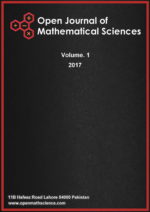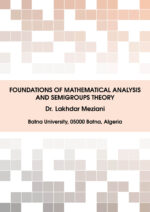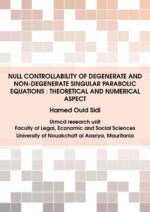Ptolemy Scientific Research Press (PSR Press)is a highly regarded publisher of scientific literature dedicated to bringing the latest research and findings to a broader audience. With a focus on cutting-edge research and technology, Ptolemy Scientific Research Press offers a range of publications catering to professionals, researchers, and student’s needs. Whether looking for information on the latest breakthroughs in physics, biology, engineering, or computer science, you can trust Ptolemy Scientific Research Press to deliver insightful, accurate, and engaging content. With its commitment to quality, accessibility, and innovation, Ptolemy Scientific Research Press is an essential resource for anyone interested in science and technology.

Latest Published Articles
OMS-Vol. 3 (2019), Issue 3, pp. 262 – 272 Open Access Full-Text PDF
Harish Bhatt and Abhinandan Chowdhury
Abstract: This work is concerned with a comparative study of performances of meshfree (radial basis functions) and mesh-based (finite difference) schemes in terms of their accuracy and computational efficiency while solving multi-dimensional initial-boundary value problems governed by a nonlinear time-dependent reaction-diffusion Brusselator system. For computing the approximate solution of the Brusselator system, we use linearly implicit Crank-Nicolson (LICN) scheme, Peaceman-Rachford alternating direction implicit (ADI) scheme and exponential time differencing locally one dimensional (ETD-LOD) scheme as mesh-based schemes and multiquadric radial basis function (MQRBF) as a meshfree scheme. A few numerical results are reported.
On codes over \(\mathbb{R}=\mathbb{Z}_{2}+u\mathbb{Z}_{2}+u^2\mathbb{Z}_{2}\) where \(u^3=0\) and its related parameters
OMS-Vol. 3 (2019), Issue 3, pp. 256 – 261 Open Access Full-Text PDF
Chella Pandian Panchanathan
Abstract: In ring \(\mathbb{R}=\mathbb{Z}_{2}+u\mathbb{Z}_{2}+u^2\mathbb{Z}_{2}\) where \(u^3=0,\) using Lee weight and generalized Lee weight, some lower bound and upper bound on the covering radius of codes is given and also to find the covering radius for various repetition codes with respect to same and different length in \(\mathbb{R}.\)
A mathematical model showing the potential of vitamin c to boost the innate immune response
OMS-Vol. 3 (2019), Issue 3, pp. 245 – 255 Open Access Full-Text PDF
Anuraag Bukkuri
Abstract: There has been much debate about the role Vitamin C plays in the innate immune response, and if it has the potential to be used as a drug to combat conditions in which the immune system is compromised, from the common cold to cystic fibrosis. Here, the author creates a basic model of the innate response, capturing the dynamics among phagocytic cells, host cells, foreign virus/bacteria, and Vitamin C. Through mathematical simulations, the author concludes that Vitamin C can be used as a stand-alone drug to eradicate a viral/bacterial infection if given constant infusions. If this is not possible due to other side effects that may harm the patient, Vitamin C may be used in quick succession with another anti-bacterial/anti-viral medication to aid the patient. This, moreover, could help minimize the amount of side effects of the anti-bacterial/anti-viral drug and slow down bacterial evolution. Finally, the author modifies the system to simulate cases of renal failure, acute lung injury, liver damage, chronic granulomatous disease, and the Chédiak-Higashi syndrome, showing how Vitamin C can help individuals with these diseases.
Exponentiated transmuted lindley distribution with applications
OMA-Vol. 3 (2019), Issue 2, pp. 1 – 18 Open Access Full-Text PDF
Emmanuel W. Okereke
Abstract: In this paper, we study a new distribution called the exponentiated transmuted Lindley distribution. The proposed distribution has three special cases namely Lindley, exponentiated Lindley and transmuted Lindley distributions. Along with the basic properties of the distribution, the maximum likelihood technique of estimating the parameters of the distribution are discussed. Two applications of the distribution are also part of this article.
M-polynomial of some cactus chains and their topological indices
ODAM-Vol. 2 (2019), Issue 2, pp. 59 – 67 Open Access Full-Text PDF
Bommanahal Basavanagoud, Anand P. Barangi
Abstract: In this note, we first show that the general Zagreb index can be obtained from the \(M-\)polynomial of a graph by giving a suitable operator. Next, we obtain \(M-\)polynomial of some cactus chains. Furthermore, we derive some degree based topological indices of cactus chains from their \(M-\)polynomial.
Translation and homothetical TH-surfaces in the 3-dimensional Euclidean space \(\mathbb{E}^{3}\) and Lorentzian-Minkowski space \(\mathbb{E}_{1}^{3}\)
OMS-Vol. 3 (2019), Issue 1, pp. 234 – 244 Open Access Full-Text PDF
Bendehiba Senoussi, Mohammed Bekkar
Abstract: In the 3-dimensional Euclidean space \(\mathbb{E}^{3}\) and Lorentzian-Minkowski space \(\mathbb{E}_{1}^{3},\) a translation and homothetical TH-surface is parameterized \(z(u,v)=A(f(u)+g(v))+Bf(u)g(v),\) where \(f\) and \(g\) are smooth functions and \(A\), \(B\) are non-zero real numbers. In this paper, we define TH-surfaces in the 3-dimensional Euclidean space \(\mathbb{E}^{3}\) and Lorentzian-Minkowski space \(\mathbb{E}_{1}^{3}\) and completely classify minimal or flat TH-surfaces.








